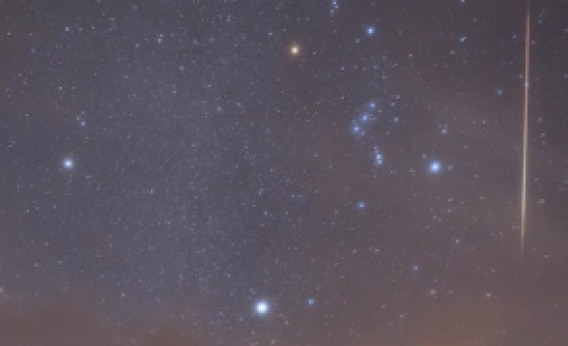Create a free profile to get unlimited access to exclusive videos, sweepstakes, and more!
The Hunter and the Meteor

Last week was the peak of the annual Taurid* and Leonid meteor showers, when the Earth plows through the debris sloughed off by the comet Tempel-Tuttle, treating the denizens of our planet to a cascade of shooting stars.
Iâve seen a lot of photos from the event, but I shouldâve known that my pal Randy Halversonâa gifted astrophotographer and maker of stunning time lapse videosâwould take one that would make my jaw drop to my desk.
Holy. Wow. You absolutely want to click that picture to embiggen it.
Ignoring the meteor for a momentâif you can!âOrion dominates the frame, with the bright star Betelgeuse glowing orange-red on the Hunterâs right shoulder (on the left in the picture, since Orion is usually depicted as facing us). Someday, almost certainly in less than a million years, Betelgeuse will explode as a supernova, and for a few weeks will be so bright you could read by it.
To the lower left of Orion is Sirius, the brightest star in the night sky. Itâs a binary star, two stars orbiting each other, one about twice the mass of the Sun and far more luminous, the other a faint spark of a white dwarf, a dead star too faint to see without a telescope. Theyâre only about 9 light years away, which is why they appear so bright. Proximity means power when it comes to the starry night. Usuallyâ¦
But not always. Rigel, the star marking Orionâs left knee (on the right to us) is roughly a thousand light years away and still one of the brightest stars in the sky; that means itâs an actual superstar, over 100,000 times more luminous than our Sun! If it were as close as Sirus, it would be comparable in brightness to the Moon.
So, yeah.
I could go on and on, describing what you see in this picture. Randy shoots most of his work in South Dakota, where skies get very dark. This was on the White River, and he used a 30 second exposure to capture this shot. You can just see the stars trailing a bit in the higher-res version, streaking a little as the Earth turns underneath them, carrying them east to west across the sky. The meteor, though, isnât blurred because it screamed across the sky in less than a second! It was probably no bigger than a tiny grain of sand, but moving at 70 kilometers per second (40+ miles per second), dozens of times faster than a rifle bulletâfast enough to cross the continental United States in just over one minute. Its tremendous energy of motion was converted into heat, causing the air around it to glow, and the meteoroid (the grain itself) to vaporize.
It was part of a comet for billions of years, found itself freed of that icy domain just a few years ago, then ended as brilliant flash of light and drama in our atmosphere in less than a single second. If thereâs a lesson in that, feel free to find it.
And you might think that Randy was lucky to capture this shot, but luck had very little to do with it. He goes outside at night all the time to capture the beauty of the heavens. Itâs not luck, itâs inevitability. Go out enough and you will see all manners of amazing things.
Go. Look up. See what there is to see. Youâll be amazed at whatâs going on just over your head.
Correction, Nov. 25: The article originally omitted the Taurid meteor shower, which occurs at the same time as the Leonid. The photo caption originally misidentified a meteor as being from the Leonid shower, when it is actually from the Taurid shower.


























